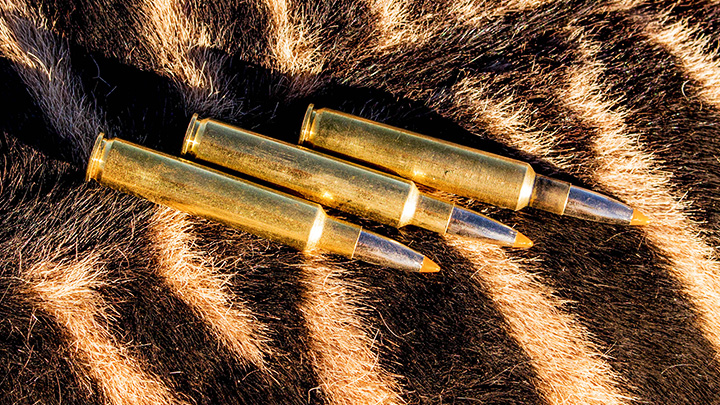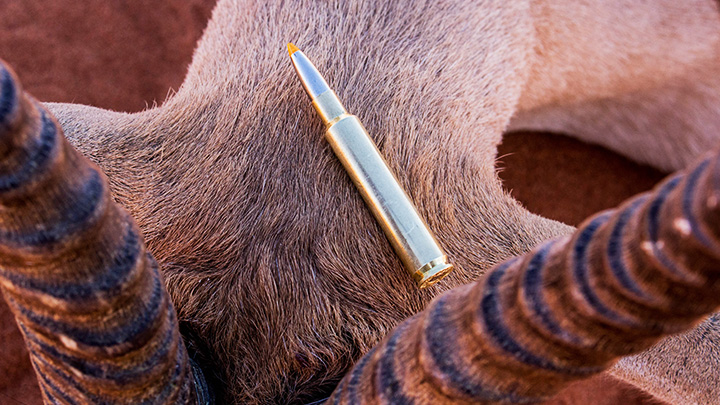
We had not needed to discuss whether or not we were going to take this ram, there was just the mad scramble to get off the cruiser, grab the sticks and begin the half-mile stalk. Even at that distance, he stood out like a sore thumb; there are springbok, and then there are springbok. Professional Hunter Maria van der Merwe and I were just chatting quietly, ironically discussing what constituted a trophy springbok ram, when what is more than likely the springbok of my lifetime stood against the brick-red dunes, and we both knew immediately.

With the severe drought, cover was at a premium, and 300 yards was the best the two of us could do. He spread the sticks, I settled the crosshairs of the .280 Ackley Improved, and squeezed the trigger. The sound of the 160-grain Trophy Bonded Tip striking flesh was sweeter than honey, and the closer we got to the dead ram, the bigger he got.
Hunting plains game in Namibia requires a cartridge which can cover a good number of scenarios, as you may have an animal as large as an eland bull (approaching a ton) at under 50 yards in the bush, or an animal as small as a steenbok, duiker or springbok across the open pan. For this hunt I chose two rifles: a .300 H&H (an undeniable African classic) and the .280 Ackley Improved. I’m glad I did; it was an eye-opening experience.

There are no flies on the .280 Remington—in fact, mating the older .30-03 case with 7mm bullets resulted in a very efficient and useful design—but as with any good cartridge, the tinkerers are going to have a go. Fred Huntington, founder of RCBS, developed the .280 RCBS by blowing out the body taper of the .280 Remington and changing the shoulder angle to 35-degrees. P.O. Ackley, the famous gunsmith and ballistician, changed the shoulder to 40-degrees, lent his surname, and the .280 Ackley Improved was born. Like most of the Ackley Improved cartridges, the .280 AI gives a definite velocity advantage over the standard .280 Remington, but whether you need that or not shall be seen in just a moment.
I first heard the accolades of the .280 AI when the magazines starting covering a southern gunsmith named Kenny Jarrett, quite a while ago now. His ‘Bean Field’ rifles were hailed as the most accurate rifles of their time—and remain impressive—but it was Jarrett who sang the praises of the .280 Ackley Improved, with regards to its accuracy and terminal performance. At the time, the .280 AI was still a wildcat, though in 2007, Nosler registered the cartridge with SAAMI, and began the production of factory-loaded ammunition. Using a case length of 2.525 inches, the .280 Ackley Improved fits nice in a standard long-action receiver, and in spite of the steep shoulder, I have found the cartridge will feed well in most rifles. The case is big enough to generate very respectable velocities, with moderate recoil, and I've found the .280 AI to be very accurate.

While the .280 Remington is certainly a solid design, I find the higher velocities of the .280 AI to make it worthwhile. True, you can make the case for the balanced performance of the .280 Remington, as it can be viewed as “enough gun.” But the additional case capacity of the .280 Ackley Improved results in a 75 to 175 fps velocity advantage over the .280 Remington, and will nearly equal (and sometimes beat) the velocity of the 7mm Remington Magnum. My own favorite handload for my .280 AI uses a 160-grain Federal Trophy Bonded Tip and a healthy charge of Reloder 23 at a muzzle velocity of 2995 fps; this load makes a perfect choice for an all-around cartridge, for everything shy of the true heavyweights. The 140- and 150-grain bullets can handle any and all of the deer, the 150, 160 and 175s are excellent choices for elk, moose, bear and other heavier species. There are those who feel—and rightfully so—that the selection of 7mm projectiles are just perfect for North American hunting, and I personally feel the .280 Ackley Improved is just about the perfect means of launching those bullets. I consider the .280 AI to be a beltless magnum, with velocity equal to the 7mm Rem. Mag., with a definite reduction in recoil.
Factory ammunition is available from Hornady, with a 162-grain ELD-X in the Precision Hunter line, from Nosler, with a selection of AccuBond, Partition, E-Tip and Ballistic Tip, and most recently from Federal, in their new Terminal Ascent line, built around the 155-grain Terminal Ascent polymer tip, boat tail bonded core bullet. Rifles are available from Nosler, Cooper, Kimber and Savage (my own rifle is a Savage Long Range Hunter), so there are lots of options for any budget. And though the .280 AI doesn’t have the popularity of the .30-06 Springfield or .270 Winchester, it most definitely blends the best attributes of the two, giving the shooter better velocities than the .30-06 can offer, and heavier bullet choices than are available in the .270 Winchester. In a pinch, the .280 AI chamber can and will handle .280 Remington ammo—and rather accurately, I might add—and the result is fire-formed brass cases for the Ackley Improved chamber.

Reloading for the .280 Ackley Improved is straight-forward; there are good dies available from most major manufacturers, good data from a number of reliable sources, and a good large rifle primer will spark the powder column reliably. I like Nosler component brass for my handloads, and Alliant’s Reloder 23—and powders with a similar burn rate—makes a good choice for fueling that case.
Are you going to find ammunition for the .280 Ackley Improved in that backwoods gun shop we’re always talking about? Probably not, but I doubt you’ll find ammo for the .280 Remington very often. But if you want something a bit unique, with a definite cool factor, give the .280 Ackley Improved a long look. I think it’s the best of Ackley Improved line, and I truly enjoy shooting and hunting with mine.
Looking for previous installments of our "Behind the Bullet" series? We've got you covered.
• .240 Weatherby Magnum
• .458 Lott
• .264 Winchester Magnum
• .348 Winchester
• .33 Nosler
• .260 Remington
• .30-30 Winchester
• .416 Rigby
• .358 Norma Magnum
• .22 LR
• 7mm-08 Remington
• 8mm Remington Magnum
• .338 Federal
• .224 Valkyrie
• .338-06 A-Square
• 9.3x62mm Mauser
• .257 Weatherby Magnum
• .45-70 Government
• .300 H&H Magnum
• .25-06 Remington
• .30-06 Springfield
• 6.5 Creedmoor
• .300 Remington Ultra Magnum
• 7mm Remington Magnum
• .470 Nitro Express
• .280 Remington
• .300 Winchester Magnum
• .270 Winchester
• .222 Remington
• .45 ACP
• .404 Jeffery
• .44 Remington Magnum
• .41 Remington Magnum
• .243 Winchester
• .338 Winchester Magnum
• .357 S&W Magnum
• 6.5-284 Norma
• 8x57 Mauser
• .38 Smith & Wesson Special
• 7x57mm Mauser
• 9 mm Luger
• .35 Whelen
• .454 Casull
• .375 H&H Magnum
• .45 Colt
• .22-250 Remington
• 10mm Auto
• .308 Winchester



































